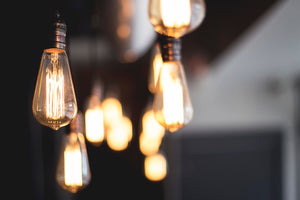
October 08, 2019
LED lighting technology has come a long way since its invention in the 20th century, and it continues to advance, bringing new and improved design possibilities to the world of light. With a union of form and functional features, such as varied sizes and style flexibility, designers can create eye-catching lighting plans with artful bulb types and intricate filament formations.
When these LED bulbs are incorporated into light fixtures, the design effect is a touch of modernity and creativity for any interior or outdoor space.
To shed light on the many benefits of LEDs, as well as some of the most common myths about them, the KingsHaven lighting design team has curated an illuminating list of things you need to know about LED lighting.

Pictured: Our KingsHaven Paris Prism Pendant, Large has an open iron frame that lets LED bulbs be visible, which adds to the overall ambience of the light.
Bountiful Benefits:
From energy savings to aesthetic appeal, LED lighting provides architects and designers with numerous benefits, while also enhancing the ambience and sense of style within a space.
Benefit #1: Energy-Efficient and Environmentally Friendly
Compared to traditional bulbs, LEDs last 25 times longer, use at least 75 percent less energy, and do not contain mercury or other toxic elements, making them an obvious and sustainable choice.
Fun Fact: On average, an LED bulb lasts 50,000 hours. That’s a lifespan of more than 11 years!

Pictured: The KingsHaven Metrique Pendant, Mini has been designed to showcase creative LED bulb selections. The light fixture and bulb work together to produce a contemporary focal point.
Benefit #2: Improved Safety / Less Hazardous
LEDs emit less heat than traditional bulbs and are resistant to shock and vibration. This means they are a safer option to use in light fixtures.
For those planning overhead lighting for places like kitchens, bathroom vanities and offices, the low-to-no-heat factor of LEDs is widening the possibilities for where and how lighting can be installed and, better yet, enjoyed.
Benefit #3: Design Flexibility
Not only do LED bulbs provide incredibly interesting illumination, they also add a unique and innovative design element to virtually any space.
The transformable characteristics of LED bulbs, such as shape, size, color, dimming capabilities, and filament options allow for greater flexibility and versatility in lighting designs.

Pictured: The variety of LED bulbs is a burgeoning trend made even more diverse with today’s thinner and curving light filaments.
Misconstrued Myths Explained:
Myth #1: LED bulbs cannot look good in a traditional light fixture.
LED bulbs can be integrated into traditional light fixtures to give them a modern twist and fresh, fabulous look. We’ve designed all KingsHaven light fixtures to be fully compatible with LED bulbs. With KingsHaven, the lighting design possibilities are just about limitless.

Pictured: The KingsHaven Metrique Pendant, Large is paired with LED candelabra bulbs, blending design elements from both traditional and modern styles.
Myth #2: LEDs only produce very bright, white-blue light.
LEDs produce a range of light, some of them beautiful and warm. Even white-blue light with a tinted glass bulb can look very attractive. Using a warm-tinted glass bulb can dial a light’s color temperature down and produce a warmer tone and glow.
In order to guarantee your desired lighting for a space, Kelvin (K) and lumens are two must-know specifications. The color temperature of a light is measured in degrees of Kelvin on a scale from 1,000K to 10,000K. The lower the Kelvin value, the “warmer” and more yellow or golden the light will appear. The higher the Kelvin value, the “cooler” and bluer the light will look. Unlike traditional bulbs, LEDs are measured in lumens, not watts. Lumens determine the amount of light a bulb produces, whereas watts measure energy consumption.

Pictured: Kelvin Color Temperature Scale
Myth #3: LEDs are more expensive than traditional bulbs.
LED lighting is actually less expensive by far because the bulbs last much longer. It is the equivalent of investing in 3 traditional light bulbs when you invest in 1 LED bulb. Your clients will appreciate the long-range benefits.
The upfront cost of LEDs may be slightly higher than traditional bulbs. However, the overall return and savings you’ll achieve, as a result of their extremely long lifespan and low-energy use, prove them to be more cost-effective.

Pictured: The beauty of the KingsHaven Eden Sconce is accentuated by a single tube-style LED bulb featuring a thin oval filament.
We are all about helping you light your clients’ residential and commercial spaces with innovation and ease.
June 10, 2022
August 27, 2021